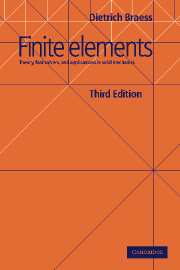Book contents
- Frontmatter
- Contents
- Preface to the Third English Edition
- Preface to the First English Edition
- Preface to the German Edition
- Notation
- Chapter I Introduction
- Chapter II Conforming Finite Elements
- Chapter III Nonconforming and Other Methods
- Chapter IV The Conjugate Gradient Method
- Chapter V Multigrid Methods
- Chapter VI Finite Elements in Solid Mechanics
- References
- Index
Preface to the First English Edition
Published online by Cambridge University Press: 01 March 2010
- Frontmatter
- Contents
- Preface to the Third English Edition
- Preface to the First English Edition
- Preface to the German Edition
- Notation
- Chapter I Introduction
- Chapter II Conforming Finite Elements
- Chapter III Nonconforming and Other Methods
- Chapter IV The Conjugate Gradient Method
- Chapter V Multigrid Methods
- Chapter VI Finite Elements in Solid Mechanics
- References
- Index
Summary
This book is based on lectures regularly presented to students in the third and fourth year at the Ruhr-University, Bochum. It was also used by the translater, Larry Schumaker, in a graduate course at Vanderbilt University in Nashville. I would like to thank him for agreeing to undertake the translation, and for the close cooperation in carrying it out. My thanks are also due to Larry and his students for raising a number of questions which led to improvements in the material itself.
Chapters I and II and selected sections of Chapters III and V provide material for a typical course. I have especially emphasized the differences with the numerical treatment of ordinary differential equations (for more details, see the preface to the German edition).
One may ask why I was not content with presenting only simple finite elements based on complete polynomials. My motivation for doing more was provided by problems in fluid mechanics and solid mechanics, which are treated to some extent in Chapter III and VI. I am not aware of other textbooks for mathematicians which give a mathematical treatment of finite elements in solid mechanics in this generality.
The English translation contains some additions as compared to the German edition from 1992. For example, I have added the theory for basic a posteriori error estimates since a posteriori estimates are often used in connection with local mesh refinements. This required a more general interpolation process which also applies to non-uniform grids. In addition, I have also included an analysis of locking phenomena in solid mechanics.
- Type
- Chapter
- Information
- Finite ElementsTheory, Fast Solvers, and Applications in Solid Mechanics, pp. xiPublisher: Cambridge University PressPrint publication year: 2007



